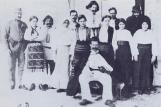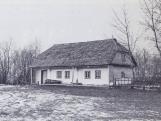1
Anna Sekundiak tells the story about her family's first years in Canada.3
My maiden name was Anna Paliukh. I was born in 1908 in Kamsack, Saskatchewan. My parents came to Canada from the village of Ivanivka, Terebovlia District, Ternopil Province. They were among the pioneer settlers in Canada. They had half a section of land.There were about two hundred acres of cultivated land on our farm which my father had bought from an English farmer. The soil was stony and early autumn frosts damaged the wheat. We moved to Prairie View where the soil was better. Later, the wind carried off the topsoil so that what was left was sandy.
Once it was possible for a family to make a living on this amount of land, but the next generation cannot survive on it, and the sons and daughters abandon the farms for the city. It used to be that a father would sign over to his son a quarter section of land and he would then buy some machinery and begin farming. Nowadays, one cannot make a go of it on half a section because a tractor costs a lot of money and a combine costs even more. Farming has to be done on a large scale if one is to succeed. As a consequence, the rural population is diminishing.
We did mixed farming because it wasn't possible to make ends meet by just growing grain. Besides, there was a quota set by the government on the amount of wheat per acre of cultivated land that could be sold. The elevators were filled to capacity with grain because Canada didn't have a market for its wheat. The farmers found it almost impossible to make a living under these conditions.
They found things especially difficult during the depression of the thirties. Many of them lost their farms because of debts and tax arrears. Their machinery and livestock were auctioned off and they were evicted from their land. I remember the case of a widow who was threatened with eviction from her farm. The neighbours rallied to her defence. She was in poor health and had three children to look after. Some farmers had to go on relief because they weren't able to feed their families. School teachers taught for as little as $250 or $300 a year.
Once, when our branch of the Ukrainian Labour-Farmer Temple Association was holding one of its meetings, we were informed that a certain woman was lying sick in bed. There were five small children in the house and the husband didn't know what to do.
We decided to take this woman to the hospital and to look after the children in the meantime. When we brought her to the hospital in Kamsack, they wouldn't admit her on the grounds that the guarantee of payment by the municipality was worthless because it had no money in its treasury. The doctor refused to perform the needed operation without someone guaranteeing the fee first. One farm woman put up twenty-five dollars and only then did the doctor agree to operate. Later, the sick woman's husband sold his last pig to pay back the money that the farm woman had generously put up.
I attended school for six years. We had to walk two miles to school, sometimes in the rain, in snowstorms and blizzards. The worst time was in spring, when the snow was melting and the roads were flooded. Sometimes, to get over a particularly bad spot, we had to walk along a strand of wire fence, from post to post. And it wasn't much of a school that we attended. It would happen that we would come to school but the teacher wouldn't be there - he would either be repairing his car or else working somewhere on his farm, and we would spend the whole day playing games. There were times when he would turn up in the afternoon, telling us not to say anything about it to our parents. Then he would put some of us in his car and take us for a ride.
ANNA SEKUNDIAK
KAMSACK, SASKATCHEWAN
interview by Peter Krawchuk
4
Rural dramatics in Plum Ridge School1912
Pleasant Home, Manitoba, Canada
 Credits:
Credits:National Archives of Canada
